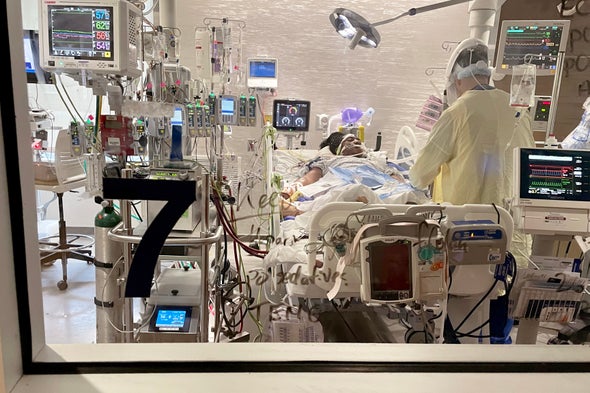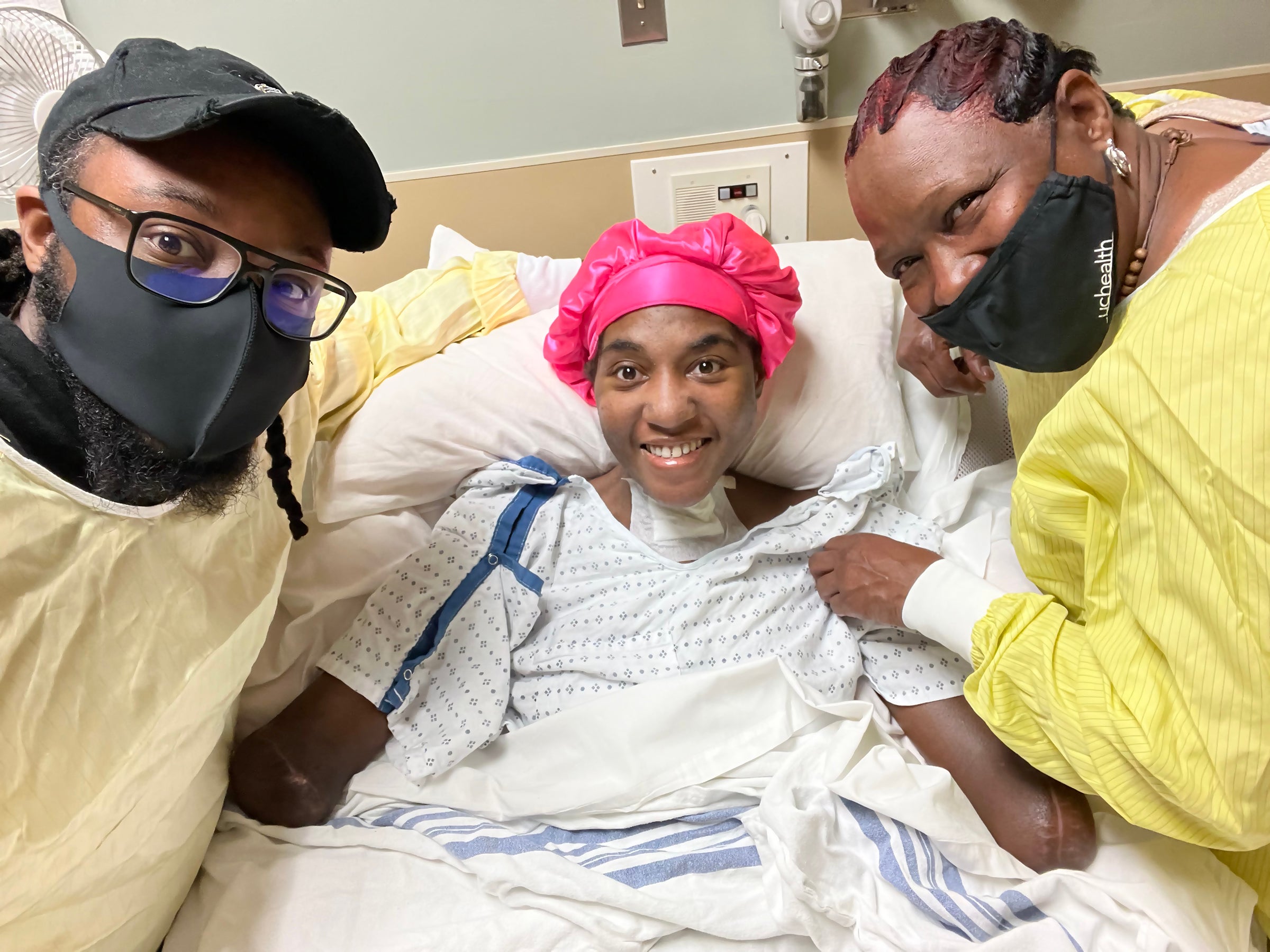Some COVID Patients Need Amputations to Survive
Impaired blood flow leads to loss of limbs
January 12, 2022
https://www.scientificamerican.com/tag/The+Coronavirus Outbreak/
Carolyn Barber has been an emergency department physician for 25 years. She is co-founder of the homeless work program Wheels of Change and author of many articles and the book Runaway Medicine: What You Don't Know May Kill You, which was recently Amazon's number-one Hot New Release in Health Care Administration. She received her M.D. at the Johns Hopkins University School of Medicine.

Candice Davis, age 30, in an intensive care unit. Diagnosed with myocarditis and cardiogenic shock stemming from COVID, Davis spent weeks in a medically induced coma. Credit: Paige Davis
In late summer Candice Davis and her brother, Starr, returned to South Philadelphia from a trip to Mexico, and Davis quickly knew that something was wrong. Both she and Starr felt ill, and both subsequently tested positive for COVID-19. But Starr, who had been immunized, experienced only mild flulike symptoms and felt better within a few days. For his unvaccinated sister, a nightmare began to unfold.
Candice, age 30, quarantined for two days but soon noticed that things were worsening. She started to feel her heart “skipping beats.… I was burning up,” she tells me. She called an ambulance. At the Penn Presbyterian Medical Center, Davis’s blood pressure plunged to 70/50, and she was diagnosed with myocarditis, an inflammation of the heart muscle, caused by infection with the novel coronavirus.
In essence, Davis’s heart was barely pumping. Her treating physician, Nayelah Sultan, says the heart was functioning so poorly that her doctors considered her for a cardiac transplant. Davis also experienced atrial fibrillation, a sudden acceleration of her heartbeat. Her doctors shocked her heart back into a normal rhythm.
Doctors explained to Davis that she needed to have a breathing tube inserted and to be placed on a ventilator. “I freaked out,” she says, “because I had heard the stories.” After a conversation with her mother, she agreed to the procedure. Hours later, Davis was also placed on extracorporeal membrane oxygenation (ECMO), a heart-lung machine for life support, because she remained critically ill. She was started, too, on an anticoagulant that thins the blood to help prevent clots.
“It was a hot mess,” says Paige Davis, Candice’s mother. Her daughter had lines going in and out of her groin, and she required fasciotomies (cuts made into the muscle) to treat possible compartment syndrome in her legs. “It started with the heart,” Paige says, “but as time went on, everything started to crash.”

Candice Davis with brother Starr and mother Paige. Starr Davis became infected on the same trip as Candice. Previously vaccinated, he recovered quickly and without complication. Credit: Starr Davis
Placed in a medically induced coma, Candice Davis doesn’t remember much from those first few weeks. But she knows what she saw when she awoke: “My arms and my feet, super black and, like, dead,” she says. “It was terrible.”
Lack of blood flow to Davis’s extremities led to the amputation of one arm above the elbow, one arm below the elbow, one leg below her knee and half her right foot. Her COVID could have killed her, but these procedures saved her life.
Davis’s case shows one of the underappreciated dangers of the disease. As many reports have indicated, SARS-CoV-2, the virus that causes COVID, is associated with a risk of clotting complications such as acute limb ischemia, or ALI. This refers to a sudden decrease in blood flow to a limb, usually because of a blood clot—that is, a thrombosis or embolism—in an artery. When traffic comes to a standstill on one of these arterial thoroughfares, limb viability can be threatened. In Davis’s case, “the prothrombotic state from COVID is probably the thing that made it so, so bad,” says her vascular surgeon Julia Glaser.
How and why these arterial clots form in ALI is unclear, but some experts believe that inflammation and endothelial injury (damage to the inner lining of blood vessels) incited by the virus are likely contributors. “When the endothelium is not working well and its job is to keep keeping blood moving, it’s more prone to clot,” Glaser says.
Impaired blood flow leads to loss of limbs
January 12, 2022
https://www.scientificamerican.com/tag/The+Coronavirus Outbreak/
Carolyn Barber has been an emergency department physician for 25 years. She is co-founder of the homeless work program Wheels of Change and author of many articles and the book Runaway Medicine: What You Don't Know May Kill You, which was recently Amazon's number-one Hot New Release in Health Care Administration. She received her M.D. at the Johns Hopkins University School of Medicine.

Candice Davis, age 30, in an intensive care unit. Diagnosed with myocarditis and cardiogenic shock stemming from COVID, Davis spent weeks in a medically induced coma. Credit: Paige Davis
In late summer Candice Davis and her brother, Starr, returned to South Philadelphia from a trip to Mexico, and Davis quickly knew that something was wrong. Both she and Starr felt ill, and both subsequently tested positive for COVID-19. But Starr, who had been immunized, experienced only mild flulike symptoms and felt better within a few days. For his unvaccinated sister, a nightmare began to unfold.
Candice, age 30, quarantined for two days but soon noticed that things were worsening. She started to feel her heart “skipping beats.… I was burning up,” she tells me. She called an ambulance. At the Penn Presbyterian Medical Center, Davis’s blood pressure plunged to 70/50, and she was diagnosed with myocarditis, an inflammation of the heart muscle, caused by infection with the novel coronavirus.
In essence, Davis’s heart was barely pumping. Her treating physician, Nayelah Sultan, says the heart was functioning so poorly that her doctors considered her for a cardiac transplant. Davis also experienced atrial fibrillation, a sudden acceleration of her heartbeat. Her doctors shocked her heart back into a normal rhythm.
Doctors explained to Davis that she needed to have a breathing tube inserted and to be placed on a ventilator. “I freaked out,” she says, “because I had heard the stories.” After a conversation with her mother, she agreed to the procedure. Hours later, Davis was also placed on extracorporeal membrane oxygenation (ECMO), a heart-lung machine for life support, because she remained critically ill. She was started, too, on an anticoagulant that thins the blood to help prevent clots.
“It was a hot mess,” says Paige Davis, Candice’s mother. Her daughter had lines going in and out of her groin, and she required fasciotomies (cuts made into the muscle) to treat possible compartment syndrome in her legs. “It started with the heart,” Paige says, “but as time went on, everything started to crash.”

Candice Davis with brother Starr and mother Paige. Starr Davis became infected on the same trip as Candice. Previously vaccinated, he recovered quickly and without complication. Credit: Starr Davis
Placed in a medically induced coma, Candice Davis doesn’t remember much from those first few weeks. But she knows what she saw when she awoke: “My arms and my feet, super black and, like, dead,” she says. “It was terrible.”
Lack of blood flow to Davis’s extremities led to the amputation of one arm above the elbow, one arm below the elbow, one leg below her knee and half her right foot. Her COVID could have killed her, but these procedures saved her life.
Davis’s case shows one of the underappreciated dangers of the disease. As many reports have indicated, SARS-CoV-2, the virus that causes COVID, is associated with a risk of clotting complications such as acute limb ischemia, or ALI. This refers to a sudden decrease in blood flow to a limb, usually because of a blood clot—that is, a thrombosis or embolism—in an artery. When traffic comes to a standstill on one of these arterial thoroughfares, limb viability can be threatened. In Davis’s case, “the prothrombotic state from COVID is probably the thing that made it so, so bad,” says her vascular surgeon Julia Glaser.
How and why these arterial clots form in ALI is unclear, but some experts believe that inflammation and endothelial injury (damage to the inner lining of blood vessels) incited by the virus are likely contributors. “When the endothelium is not working well and its job is to keep keeping blood moving, it’s more prone to clot,” Glaser says.



 oh so now COVID diabetes or blood clots too?!
oh so now COVID diabetes or blood clots too?! 

 More fear mongering
More fear mongering